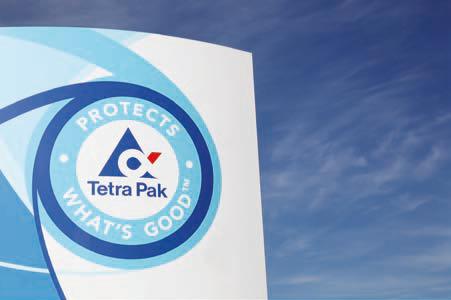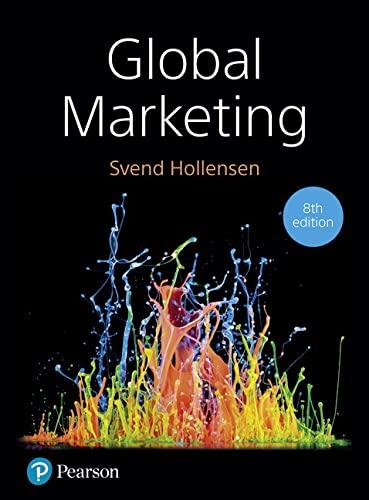In other words, what Dr Rausing is saying is that the benefits to the customer and society
Question:
In other words, what Dr Rausing is saying is that the benefits to the customer and society from packaging should outweigh the resources used and the costs of its manufacture.
Most efforts to reduce world hunger focus on increasing food production, building sustainable food chains and making food available and affordable. It is also important to do something about the fact that up to 50 per cent of the annual world food production is lost between the place where it is grown and the consumer.
Food is wasted everywhere due to maturation and poor storage, products are crushed, become oxidized, suffer water damage or are attacked by vermin and micro-organisms – mostly as a result of having either poor packaging or none at all.
Tetra Pak (www.tetrapak.com) helps with solving these huge global problems of food security by offering, for example, aseptic processing, and its packaging can preserve delicate products such as milk, juice and water safely for months without needing any preservatives or refrigeration.
Tetra Pak
Tetra Pak is one of three companies in the Tetra Laval Group – a private group that started in Sweden. The

other two companies are DeLaval and Sidel. Tetra Laval is headquartered in Switzerland. Tetra Pak is a specialist in complete solutions for the processing, packaging and distribution of food products.
Tetra Pak develops, produces and markets complete processing, packaging and distribution systems, primarily for liquid foodstuffs. Tetra Pak has expanded its business to include much more than packaging of liquid food products. Today, ice-cream, cheese, dry foods, fruits, vegetables and pet food are examples of products that can be processed or packaged in Tetra Pak processing and packaging lines.
The first products packed in Tetra Pak cartons were milk and cream. Accounting for about two-thirds of the total volume of the foodstuffs packed in Tetra Pak packages, they remain the firm’s most important products.
A wide variety of food products are process treated and aseptically packaged. Thanks to the aseptic processing and packaging systems, these products retain their taste and nutritional value, even when stored for months without refrigeration.
This packaging system has also facilitated rational and economical distribution of products in large volumes such as milk and milk-based products, juices and fruit drinks, tea drinks, soy drinks, tomato products and wine.
The Tetra Pak products are divided into several categories:
• Packages • Processing equipment • Filling machines • Distribution equipment • Service products.
Tetra Pak operates in more than 170 countries around the globe, employing more than 25,000 people.
Its customers come from different parts of the food industry, such as the dairy, cheese, ice-cream, beverage and prepared food sectors.
In 2012, 8.2 billion packages of milk and other nutritious drinks in Tetra Pak packages were provided to 67 million children in schools in over 60 countries. School feeding programmes can have a considerable impact on the local community and economy. Not only do they improve the health and learning capabilities of children, but they often act as a catalyst for agricultural and economic development.
In 2011, Tetra Pak expanded its support for school feeding programmes in Senegal, Sudan, Zambia, Honduras and Argentina among many others. School feeding programmes play a vital part in their business strategy and commitment to dairy customers around the world to make food safe and available everywhere.
The company envisaged that these programmes would be expanded in subsequent years.
Development of Tetra Pak
Ruben Rausing, the founder of Tetra Pak, was born near Helsingborg, Sweden. He graduated from the Stockholm School of Economics in 1918 at the end of World War I. By 1920, he had earned his Master of Science from Columbia University, in New York.
During his studies in the US, Rausing came across the ‘self-service grocery stores’ system in America, which was unknown in Europe at the time. He realized that pre-packaging was part of the future in food retailing as a more hygienic and practical way of distributing staple groceries, all of which were at the time sold over the counter in glass bottles or impractical paper wraps in most European countries.
Rausing’s team got the order to produce a viable packaging for milk that was cheap enough to compete with the current milk distribution system, based on loose milk sold in reusable glass bottles. The key to this was to use as little packaging material as possible. The research laboratory had tried and failed with a number of different solutions. One of the engineers in the team, Erik Wallenberg, got the idea of using one single sheet of paper rolled into a cylinder and folded from two different sides, creating a geometrical figure – a tetrahedron (this form later gave the name ‘Tetra’ to the company). The volume created only needed to be sealed in three places and the packages could be produced in one subsequent sequence from one roll of paper, using a minimum of material, with a minimum of waste. The package is still sold today under the name of Tetra Classic Aseptic.
In 1951, AB Tetra Pak was founded in Lund Sweden, by Ruben Rausing. It started as a subsidiary of Åkerlund & Rausing.
Tetra Pak’s commercial breakthrough did not arrive until the mid-60s with the new Tetra Brik® package, introduced in 1963, and the development of the aseptic technology.
International expansion had already begun at the beginning of the 1960s, when the first production plant for packaging material outside of Sweden was established in Mexico (1960), soon to be followed by another one in the US (1962). In 1964, the first Tetra Classic Aseptic machine outside Europe was installed in Lebanon. The late 1960s and the 1970s saw a global expansion of the company, much of it due to the new Tetra Brik® Aseptic package.
Tetra Pak acquired Alfa-Laval AB in 1991, a venerable Swedish company producing industrial and agricultural equipment and milk separators, a world leader in its industry. In 1993, Group Tetra Laval was created, with joint headquarters in Lund and Lausanne.
Food waste and the role of packaging
Throwing food away is tremendously wasteful. Food that is bought, cooked and then thrown away is of no use to anyone. It has been produced, packaged, transported and stored, as well as using raw materials, energy, water and packaging, completely unnecessarily.
Food that is thrown away instead of being eaten is a waste of both resources and money.
Approximately the same amount of food goes to waste in industrialized countries as in developing countries (670 and 630 million tonnes, respectively)
but for different reasons. Around 30–50 per cent of the food in developing countries is unfit for human consumption, owing to inadequate packaging and distribution, compared with 2–3 per cent in Western Europe and other industrial countries.
The main aim of food packaging is to protect the product from physical damage and keep out bacteria.
The product waste saved due to packaging has been calculated as 10 times greater than the amount of waste created by the packaging itself. In less developed countries, over 30 per cent of all food is wasted simply because of poor packaging, lack of packaging, and inadequate transport and refrigeration facilities.
In other countries, where packaging is common, this figure is significantly lower.
Technical attributes of packaging can influence how much food we waste. The following examples make a difference and are also features that consumers appreciate:
• Protects the contents
• Hygienic
• Easy to open
• Reclosability
• Easy to portion
• Easy to empty completely
• Different volume sizes
• Ambient storage.....
Questions
1. Which ‘P’ of the marketing mix should Tetra Pak concentrate on in the development of its global marketing plan?
2. Would it be relevant for Tetra Pak to work with global account management (GAM)? If yes, how should it be organized and which organizational set-up should Tetra Pak make use of?
Step by Step Answer:






